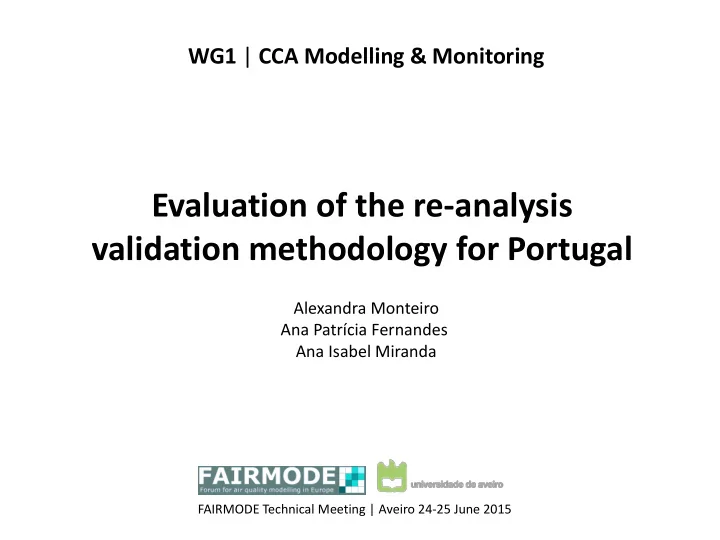

WG1 | CCA Modelling & Monitoring Evaluation of the re-analysis validation methodology for Portugal Alexandra Monteiro Ana Patrícia Fernandes Ana Isabel Miranda FAIRMODE Technical Meeting | Aveiro 24-25 June 2015
A bias correction data fusion technique STEP 1. RAT04 a multiplicative ratio correction with 4 days (for each station) obs C ( h , day ) ndays corrected mod el C ( h , day ) C ( h , day ) mod el C ( h , day ) ndays STEP 2. Spatial approach Calculate the RAT04 average factor (per hour) and apply it to all grid cells
How to validate? based on a Monte Carlo approach 1. A set of n Monte Carlo re-analyses has to be done a) For each one randomly select 20% of the stations to be used as validation stations (do not use them to perform the re-analysis) b) Compute for each station i (at least) in each re-analysis j the RMSE (i,j) 2. Compute for each station i the maximum of RMSE (i,j). Let be vect_max(i) the number of the re-analysis associated to the maximum RMSE for station i 3. Create a CDF file to be used in the DELTAtool by selecting for each station i the vect_max (i) 4. Use the Deltatool as if the CDF file was the CDF of a single model
Case study: modeling setup Problem for spatial average of RAT04 factor 39 • Measures: 50 monitoring sites • EURAD Model: TCAM • Year:2005 2013 Domain resolution:6x6km 2 (POMI exercise) • 5x5 km 2 • Pollutants: PM10 O 3
Results of Monte Carlo approach Stations/Re- analysis 1 2 3 4 5 6 7 8 9 10 11 12 13 14 15 16 17 ALF 24,8 24,1 24,0 22,7 ALV 20,6 20,5 20,7 ARC 22,3 21,6 22,1 22,8 22,6 22,4 22,3 22,5 AVN 24,9 23,8 22,6 23,0 CER 28,7 29,0 29,9 CHA 23,1 21,9 23,4 22,0 23,6 23,2 COI 23,3 22,0 CUS 19,9 20,2 ENT 23,3 24,0 23,3 23,5 23,4 ERM 21,7 20,9 21,3 20,7 ERV 18,6 ESP 23,2 22,3 23,6 21,8 24,4 23,1 22,2 FPO 19,8 19,6 19,8 19,8 19,6 FRN 27,8 29,0 28,4 FUN 22,6 22,6 22,8 22,3 HRT 24,0 24,6 24,6 ILH 21,4 21,2 20,8 JMG 22,7 23,0 22,1 23,5 23,3 LAR 21,6 LEC 38,0 37,7 38,1 LNH 20,3 20,2 19,4 20,8 LOU 20,7 20,7 MAL 18,4 18,6 17,9 18,5 MCH 21,2 22,3 20,3 21,5 21,7 MEM 20,6 21,2 21,3 MOV 27,0 OLI 21,3 21,5 21,7 21,7 OLO 26,0 24,7 PFR 38,4 38,6 PPI 19,1 18,9 RES 20,5 20,4 20,3 20,7 SMN 26,6 28,4 27,6 26,4 26,5 27,9 SOB 21,6 21,5 20,8 SON 29,8 28,8 30,4 30,2 STR 24,6 TEI 26,8 28,8 27,4 27,6 26,1 27,9 TER 23,3 24,1 22,9 VCO 22,3 21,3 VNT 18,1 19,5 21,8 22,4 22,2 25,3 23,1 24,3 23,5 23,3 25,6 22,8 24,8 21,8 24,7 22,9 25,1 22,8 23,1
Before and after RAT04
Using the DELTA Tool Selecting for each station the worst possible timeseries
Using the DELTA Tool BEFORE RAT04 AFTER RAT04 and Monte Carlo approach
Using the DELTA Tool Selecting the interaction with worst average RMSE
Some comments • Very exhaustive methodology (mainly when the data fusion technique do not bring significant improvements) • Only operational/automated is feasible • A group of Matlab/Python programs was developed by UAVR and can be available for FAIRMODE community • Maximum RMSE per station or per iteration (re-analysis) should be reviewed • Results still need a deep analysis: too “fresh”!!
Recommend
More recommend